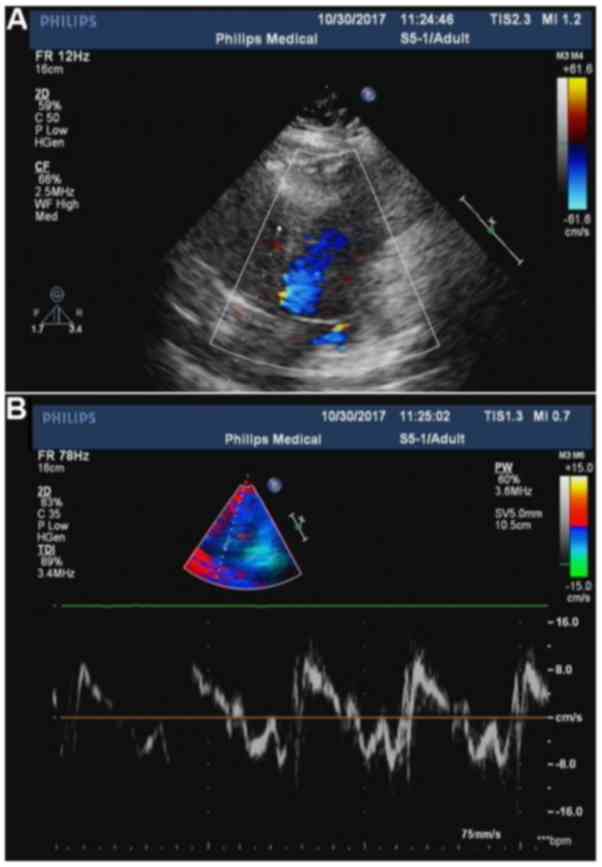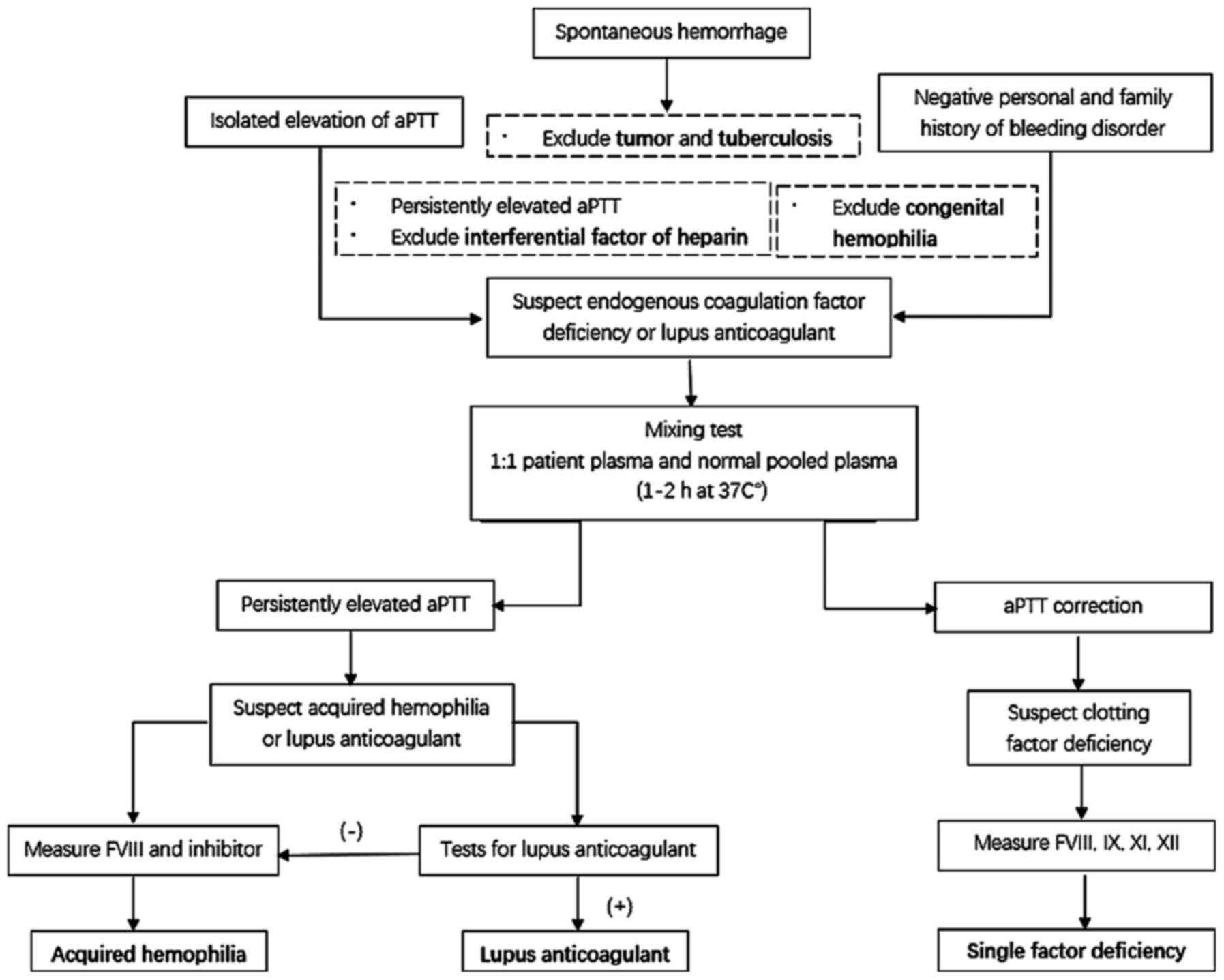|
1
|
Vautier M, de Boysson H, Creveuil C,
Repesse Y, Borel-Derlon A, Troussard X, Damaj GL, Bienvenu B,
Gautier P and Aouba A: Influence of factor VIII level and its
inhibitor titer on the therapeutic response to corticosteroids
alone in the management of acquired hemophilia. Medicine
(Baltimore). 95:e52322016. View Article : Google Scholar : PubMed/NCBI
|
|
2
|
Sakurai Y and Takeda T: Acquired
hemophilia A: A frequently overlooked autoimmune hemorrhagic
disorder. J Immunol Res. 2014:3206742014. View Article : Google Scholar : PubMed/NCBI
|
|
3
|
Collins P, Baudo F, Huth-Kühne A,
Ingerslev J, Kessler CM, Castellano MEM, Shima M, St-Louis J and
Lévesque H: Research article Consensus recommendations for the
diagnosis and treatment of acquired hemophilia A. BMC Research
Notes Notes Research Notes. 3(161)2010.
|
|
4
|
Aljasser MI, Sladden C, Crawford RI and Au
S: Bullous pemphigoid associated with acquired hemophilia A: A rare
association of autoimmune disease. J Cutan Med Surg. 18:123–126.
2014. View Article : Google Scholar : PubMed/NCBI
|
|
5
|
Olteanu M, Niţu M and Golli A:
Tuberculosis mesenteric adenopathy and polyserositis. Rom J Morphol
Embryol. 53:835–840. 2012.PubMed/NCBI
|
|
6
|
Kruse-Jarres R, Kempton CL, Baudo F,
Collins PW, Knoebl P, Leissinger CA, Tiede A and Kessler CM:
Acquired hemophilia A: Updated review of evidence and treatment
guidance. Am J Hematol. 92:695–705. 2017. View Article : Google Scholar : PubMed/NCBI
|
|
7
|
Bitting RL, Bent S, Li Y and Kohlwes J:
The prognosis and treatment of acquired hemophilia: A systematic
review and meta-analysis. Blood Coagul Fibrinolysis. 20:517–523.
2009. View Article : Google Scholar : PubMed/NCBI
|
|
8
|
Chinese society of hematology: Chinese
expert consensus on the diagnosis and treatment of acquired
hemophilia A. Zhonghua Xue Ye Xue Za Zhi. 35:575–576. 2014.(In
Chinese). PubMed/NCBI
|
|
9
|
Coppola A, Franchini M, Castaman G,
Santagostino E, Santoro C, Santoro RC, Morfini M, Minno GD and
Rocino A; and on behalf of the AICE ad hoc Working Group, :
Treatment regimens with bypassing agents in patients with
hemophilia A and inhibitors: A survey from the Italian association
of hemophilia centers (AICE). Semin Thromb Hemost. 44:551–560.
2018. View Article : Google Scholar : PubMed/NCBI
|
|
10
|
Brandt JT, Barna LK and Triplett DA:
Laboratory identification of lupus anticoagulants: Results of the
second international workshop for identification of lupus
anticoagulants. Thromb Haemost. 74:1597–1603. 1995. View Article : Google Scholar : PubMed/NCBI
|
|
11
|
Kumano O, Amiral J, Dunois C, Peyrafitte M
and Moore GW: Paired APTTs of low and high lupus anticoagulant
sensitivity permit distinction from other abnormalities and achieve
good lupus anticoagulant detection rates in conjunction with dRVVT.
Int J Lab Hematol. 24:2018.
|
|
12
|
Thrombosis and Hemostasis Group, Chinese
Society of Hematology, Chinese Medical Association: Chinese expert
consensus on the diagnosis and treatment of acquired hemophilia A
(Chinese). Chin J Hematol. 35:575–576. 2014.
|
|
13
|
Greaves M, Cohen H, MacHin SJ and Mackie
I: Guidelines on the investigation and management of the
antiphospholipid syndrome. BrJ Haematol. 109:704–715. 2000.
View Article : Google Scholar
|
|
14
|
Theodossiades G, Tsevrenis V, Nomikou E,
Dadiotis L and Kontopoulou-Griva L: Surgery-associated acquired
hemophilia A. Ann Hematol. 80:691–693. 2011.
|
|
15
|
Bouvry P and Recloux P: Acquired
hemophilia. Haematologica. 79:550–556. 1994.PubMed/NCBI
|
|
16
|
Sborov DW and Rodgers GM: Acquired
hemophilia A: A current review of autoantibody disease. Clinical
Advances in Hematol Oncol. 10:19–27. 2012.
|
|
17
|
Delgado J, Jimenez-Yuste V,
Hernandez-Navarro F and Villar A: Acquired haemophilia: Review and
meta-analysis focused on therapy and prognostic factors. Br J
Haematol. 121:21–35. 2003. View Article : Google Scholar : PubMed/NCBI
|
|
18
|
Collins PW and Percy CL: Advances in the
understanding of acquired haemophilia A: Implications for clinical
practice. Br J Haematol. 148:183–194. 2010. View Article : Google Scholar : PubMed/NCBI
|
|
19
|
Shetty S, Bhave M and Ghosh K: Acquired
hemophilia A: Diagnosis, aetiology, clinical spectrum and treatment
options. Autoimmun Rev. 10:311–316. 2011. View Article : Google Scholar : PubMed/NCBI
|
|
20
|
Federici AB, Budde U, Castaman G, Rand JH
and Tiede A: Current diagnostic and therapeutic approaches to
patients with acquired von Willebrand syndrome: A 2013 update.
Semin Thromb Hemost. 39:191–201. 2013. View Article : Google Scholar : PubMed/NCBI
|
|
21
|
Tanaka I, Amano K, Taki M, Oka T, Sakai M,
Shirahata A, Takata N, Takamatsu J, Taketani H, Hanabusa H, et al:
A 3-year consecutive survey on current status of acquired
inhibitors against coagulation factors in Japan: Analysis of
prognostic factors. Japanese J Thromb Hemost. 19:140–153. 2008.
View Article : Google Scholar
|













